Whether you’re looking for your first guitar or you’re in a bind and needing an electric 6 string on a shoestring budget, you’ll be extremely surprised by what you can pick up affordably these days. Even with a budget is as low as $300, you’ll find some excellent options that play well, sound good, and look great, too.
To help you find the Best Electric Guitars under $300, we’ve put together this KillerGuitarRigs Review. We got our hands on 7 of the best guitars in this price bracket to show you just how much bang you can get for your buck.
When reviewing these guitars, we looked at everything from style and looks to tone and build quality. If you’re trying to find a great guitar for under $300, you’re definitely going to want to keep on reading.
Read more about our review process.
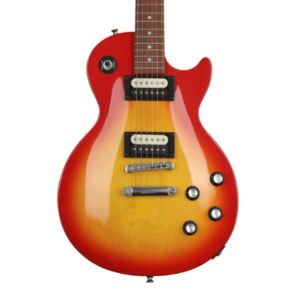
Epiphone Les Paul Studio E1
Features: Rosewood fretboard, Mahogany body, Zebra humbuckers
Benefits: Real Les Paul feel, Fat tones, Great reliability
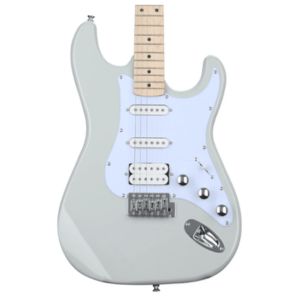
Kramer Focus VT-211S
Features: Mahogany body, Slim maple neck, Strat style construction
Benefits: Rich tones, Super forgiving, Great feel
Contents
Our Top 3
When it comes to a blend of price and performance, it’s hard to beat our Top Pick, the Yamaha PAC112J Pacifica. It offers some of the best construction quality in the category, great tones, and costs way less than its spec sheet would lead you to believe.
If you’re looking for a guitar that costs as little as possible, but still offers decent performance and playability, our Best Budget pick is the Kramer Focus. It comes in a great range of colors and, despite being the cheapest in the list, is still very well spec’d.
Players who don’t mind getting up near the top of their $300 budget should consider our Editor’s Choice, the Epiphone Les Paul Studio E1. It offers practically everything you’d expect from an LP at a fraction of the cost.
Individual Reviews
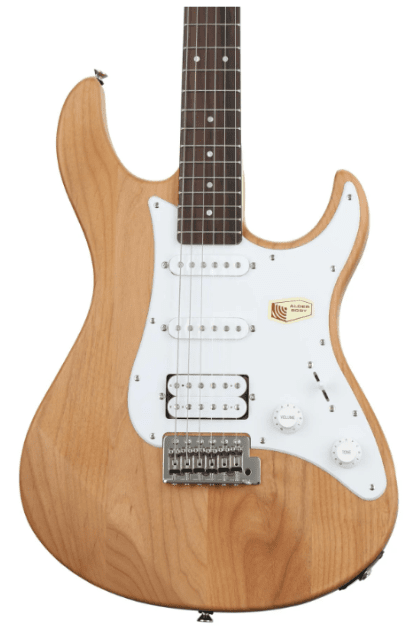
Yamaha Pacifica PAC112J
One of the best budget S Style guitars on the market, period.
It’s no secret that Yamaha have quite the reputation when it comes to overdelivering on tone and quality on what are often understated and often underestimated guitars. This Strat style model offers an unbelievable spec for a very modest price, including quality woods, hardware, and electronic components.
The Yamaha Pacifica PAC112J had an S-style alder body, but in typical Yamaha fashion, it’s much more than a straight copy (check out our full review). The dimensions were noticeably different than those of a Stratocaster, giving the Pacifica its own style. Our test model had an Old Violin Burst finish, which looked great and was flawlessly applied.
The Maple neck had a really comfortable C profile with a lovely satin finish on the back for a friction-free playing experience. Unbelievably, it even had a rosewood fretboard, which is a massive feature in this price range. It offered a huge benefit in terms of both looks and feel.
We were very impressed by the fretwork, which was excellent from top to bottom. The edges were nice and smooth, the medium fret wire was well-seated and properly leveled, and we even found the crowns were well-polished.
It came with a versatile HSS pickup layout, and we found ourselves once again very impressed. The bridge position delivered thumping rock tones and epic leads, handling overdrive with ease and remaining crystal clear throughout.
We got some great quack in the intermediate positions, particularly in position 4 with the selector right between the 2 single coils. The neck position on its own was warm, with great articulation and clarity.
The bridge was a 6-point tremolo type system, which we were able to use without causing any issues with tuning stability. The tuners themselves turned with ease, and we noted no play or wobble.
Verdict: The Yamaha Pacifica PAC112J might be the most affordable model in their lineup, but it’s still extraordinarily well equipped, plus it delivers some fantastic tones. The fit and finish is way beyond its modest price and the versatility of the HSS pickup selection alone makes it worthy of consideration.
- Flawless build quality
- Great tonal variety
- Rosewood fretboard
- Only 1 master tone control
- Limited color options
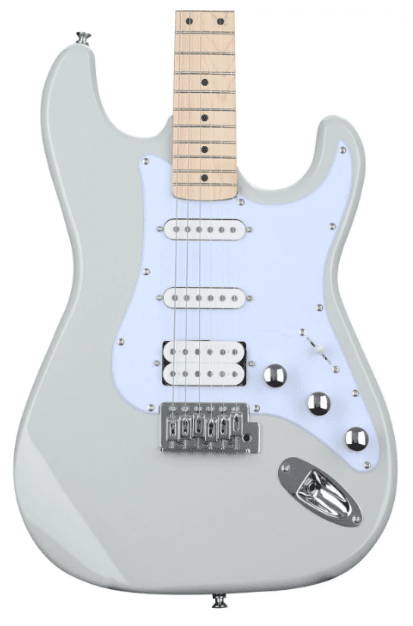
Kramer Focus VT-211S
Excellent brand pedigree and unbelievable value for money.
This is a great guitar for anybody looking to get their hands on one of the most inexpensive yet playable guitars around. Coming in 50% under budget with a $300 limit, it offers some surprisingly high end features, including a mahogany body, chromed knobs, and a HSS pickup layout.
One of most impressive things about the Kramer Focus VT-211S is the list of premium materials that have gone into the build. This is the cheapest guitar in this list by quite some margin and yet it still comes with a solid mahogany body. It’s a Strat-style guitar, so of course we found it to be comfortable to play in any situation.
It had a really nice maple neck, with a maple fretboard, too. The profile was slim, but still felt substantial, and the finish on the back was a fantastic satin that made getting up and down the neck a real joy.
Once again, we found ourselves pretty amazed by this Kramer when it came to fretwork. For a guitar costing less than $150, it was really well-finished. Everything was leveled as it should be, with no dead spots, no buzzing, and no sharp edges.
The pickups were another pleasant surprise. They served up tones to suit pretty much every genre thanks to the versatile HSS layout and Alnico magnets. The neck and middle gave us classic Strat-style chirpiness, with the signature quack in the 4th position. The bridge position was fantastic for driven rock tones and had tons of mid-range presence, which was perfect for slicing through a mix.
We really loved the knurled chromed knobs and the way they gave this Kramer a much more premium look. The 6-point trem system was definitely useable too. Many budget guitars really struggle in this area, but we didn’t encounter any tuning stability issues after using it. The tuning knobs had a unique kidney-bean style design, which worked really well and looked great.
Verdict: The Kramer Focus VT-211S is an absolute gem of a guitar. For this amount of money, there’s nothing else that even comes close. It’s got great tones, it looks fantastic, and the fact that it has a solid mahogany body really brings home just how much attention to detail has gone into this guitar. It’s a solid buy even at twice the price and we highly recommend that you check it out!
- Mahogany body
- Color matched headstock
- Quality hardware
- Plastic nut
- No position indicators on knobs
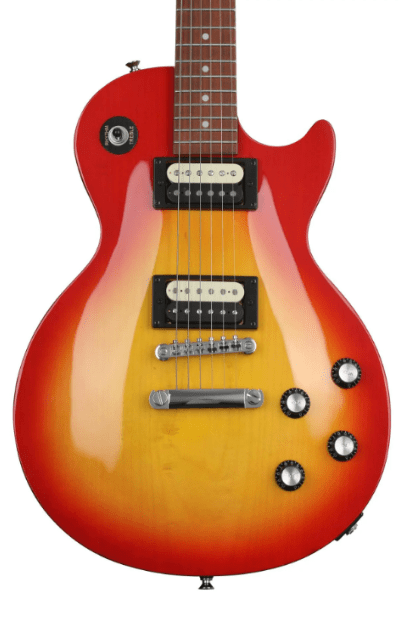
Epiphone Les Paul Studio E1
As close as you’re going to get to a real Les Paul under $300.
If you’re looking for real Les Paul feel and playability, and you absolutely have to have the Les Paul name on the headstock, with a $300 cap there’s no better way to get it than with this Epiphone. It delivers on all of the major features you’d expect from this style of guitar, including a mahogany body and neck, a carved top, and 2 screaming humbuckers.
The Epiphone Les Paul Studio E1 might be the most affordable carved top LP in the Epiphone range, but it squeezes a ton of value in for under $300. It came with a solid mahogany body and mahogany neck (like you’d find on any good Les Paul), and the top is carved, providing that familiar contour. What it doesn’t have is the maple cap, but in reality, this keeps the weight down and further adds to its comfort.
As mentioned, it had a mahogany neck, but it was a bolt-on rather than a set style. Truthfully, we didn’t even really notice while we were playing. From the front, you’d never know the difference. The neck profile was a ‘60s SlimTaper D, which is one of our favorite shapes. We found it comfortable and really fast.
Interestingly, this LP even came with a rosewood fretboard, something that you don’t typically find until you start getting to the Gibson Les Paul range. Its fretwork was well leveled, and had well-finished edges, with no sharps or sprout.
We got some great tones from the Studio E1’s zebra ceramic humbuckers. They were super hot and delivered some gnarly rock tones in both the bridge and neck positions. Even though they were hot, they still cleaned up nicely, too. We got great articulation and separation, with a particularly bright top end. There was a surprising depth to the tones from this guitar, and it was much closer to a regular Paul than the price might lead you to believe.
The hardware selection on this Les Paul was exactly as we expected. A tune-o-matic bridge with stop bar tailpiece, 4 top hat knobs, and a 3-way selector switch with poker chip surround on the upper bass side bout. The tuners weren’t Epiphone Deluxe or Grover, but they performed well. Overall tuning stability was rock solid, too.
Verdict: The Epiphone Les Paul Studio E1 was a favorite amongst the KGR staff during this roundup, and was the obvious pick for our Editor’s Choice. It delivers all the Les Paul looks, feel, and tones, while still leaving enough in your budget to buy a strap and some picks.
- Real Les Paul looks
- Great rock tones
- Rosewood fretboard
- No maple cap
- Old style Epiphone headstock
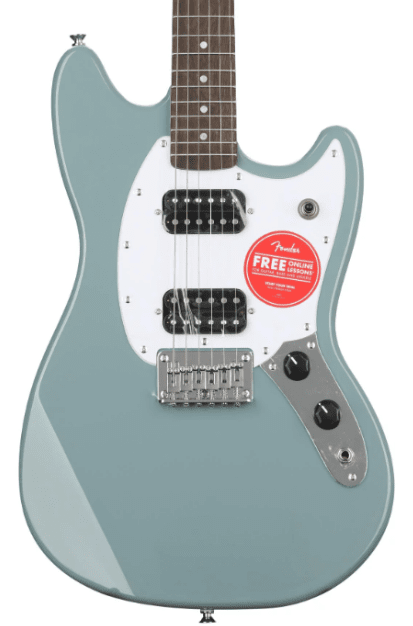
Squier Bullet Mustang
This budget Mustang is raucous, rowdy, and ready to rock.
Players looking for iconic looks, big tone, and effortless playability can’t go too far wrong with this Squier. It’s extremely well made, it can handle a wide variety of genres, and packs a massive punch for its dual humbucking pickups.
The Squier Bullet Mustang we received for this review (and for our full review) came to us in the Sonic Grey finish, which is probably our favorite of the 3 available colors. The finish was well-applied, as we’ve come to expect from Squier. The overall construction quality was great, featuring a slimline poplar body, which kept weight down and really added to the comfort factor.
It was fitted with the standard Squier C profile maple neck. It had a nice medium feel, which should appeal to a broad range of players, and the smooth, satin finish kept it playing fast without any sticky feeling.
It had a laurel fretboard, which was a little pale and dry, but wasn’t as bad as we’ve seen others in this price range. Despite this, we still found it offered good playability. It has a 24” scale, making it comfortable for smaller players, without creating extra difficulty for larger players. The fretwork was all as it should be, level with no sharp edges.
The humbuckers on this Mustang gave us a great range of hard-hitting tones. They responded well to changes in attack. We got some great cleans, with a nice full sound – classic humbucker stuff. When we pushed the amp into overdrive, they delivered some pretty aggressive crunch, making it clear why the Mustang has been a favorite in punk and grunge circles for years.
We liked the hardtail bridge especially. This really assisted with tuning stability, which can be quite a challenge on guitars at this price point if they have a trem system that isn’t properly configured. It had some pretty standard Squier sealed-gear tuners, which held firm, but weren’t the easiest for fine tuning. Not the best, but certainly could be way worse at the price.
Verdict: This Squier Bullet Mustang is a great value choice. It offers excellent playability and comfort, a good range of tones to suit most genres, and it looks really fantastic. The available color options should mean that there’s something for everybody, too.
- Quiet humbucking pickups
- Great styling
- Satin neck
- Tuner ratio makes fine tuning difficult
- Dry laurel fretboard
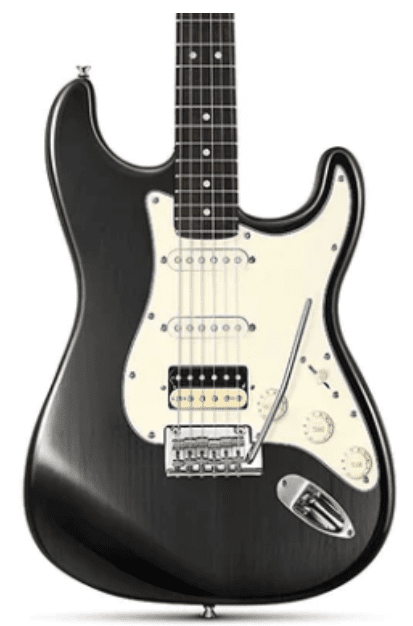
Donner DST-400
A full featured Strat copy from up and comers, Donner.
If you’re trying to get a full featured Strat for less than $300, that is, one with a full thickness body, a 2 point trem, quality pickups, and made with quality materials, the Donner DST-400 should fit the bill. It’s the brand’s flagship guitar, and it’s certainly worthy of being in the best sub $300 electric guitar conversation.
The Donner DST–400 we got for this roundup came in a gorgeous translucent green (full review here). The see-through finish showed off the grain pattern from the solid alder body. If you’re not into green, it’s also available with a translucent black finish, which looks just as good. The body is full thickness, just like you’d find on a Fender. While this made it noticeably heavier than the majority in the test, it still felt great.
It had a nice maple neck with a satin finish at the rear. We recently reviewed the Donner DST-152, and one of our chief complaints was the neck’s unfinished feel. So it’s nice to see the upgraded model get a proper neck finish. The profile was a medium C, which we found very comfortable, and comparable to the Squier C profile.
One thing that wasn’t a surprise was the dry laurel fretboard. This seems to be an issue with the vast majority of laurel boards, and while it’s relatively easy to remedy, it would be nice if it was addressed by quality control. Other than that, the fretwork was good, with no sharp edges.
The pickups were also better than anticipated. It had an HSS layout with a zebra in the bridge position and 2 regular single coils in the neck and middle. The tones from the bridge were hot, with nice bright leads that didn’t sound at all brittle. The humbucker even had coil splitting, which gave us access to some decent single coil-bridge tones as well. The neck position was warm and definitely useful, but the middle pickup was a little bland when selected on its own.
We were really excited to see that it had a 2-point trem system, but unfortunately it still led to some tuning-stability issues with anything more than moderate use.
Verdict: The Donner DST-400 might not be made by one of the big names in the business, but watch this space. Donner’s products are continuing to nip at the heels of Squier and Epiphone. It was a highly-playable option with some great feel and excellent tones, not to mention the variety provided by the coil-splitting humbucker.
- Coil splitting humbucker
- Full thickness body
- Great playability
- Tuning stability issues with trem use
- Fretboard is dry
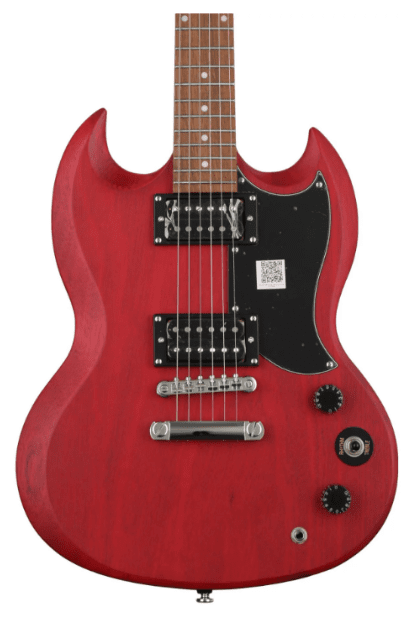
Epiphone SG Special
All the vintage SG style without the price tag.
This SG undoubtedly belongs to one of the most famous guitar families in the world, and now with this Special edition you’re able to get your hands on your very own at an insane price.
We really enjoyed spending time with the Epiphone SG Special (we even did a full review here). IT came in a classic, aged satin-cherry finish, giving it a lightly worn appearance that really suited the aesthetic. Unlike a Standard model, the body was poplar, making it lighter, but noticeably less resonant.
The neck (much like our Editor’s Choice, the Les Paul Studio E1) had a ‘60s SlimTaper D profile. Although in this case, it was made with okoume rather than mahogany. Like the body, it had a fantastic satin finish, which really allowed free movement up and down the neck for fast play.
Incredibly, it had a rosewood fretboard, something rarely found at this price point. It looked and felt great, and was generally a well-hydrated piece of wood. The fretwork was generally quite good too, although we did find one sharp fret. Fortunately it was the 19th fret, and it was only on the bass side. Thanks to the position, it would be relatively easy to address at home with a file. Additionally, the position of the fret makes it much less likely to cause issues.
The pickups were also in fact the same as those on the Les Paul, with a 650R in the neck and a 700T in the bridge, although both coils had black housing rather than zebra. The ceramic magnets provided an overall hot tone, which again delivered some nice cleans as well as aggressive overdrive. There was less sustain than we’d found with the LP, but the SG did seem to have a snappier response.
It had a simple set of sealed gear tuners which worked effectively and made tuning a hassle-free process. The hardware was generally excellent, and this includes the tune-o-matic bridge, which was nicely set up, ensuring good intonation. If you have more cash to burn, the Epiphone Les Paul custom is definitely a step up (we highlighted it in our roundup of the best electrics under $1k), but the Special isn’t far behind.
Verdict: The Epiphone SG Special is a fantastic introduction to the SG family. If you’ve been curious about this style of guitars and you’re looking to test the waters without spending a fortune, it’s a great way to go. It’s comfortable and lightweight, and it serves up some killer rock tones.
- Fantastic styling
- Generally very comfortable
- Fast neck
- Found a sharp fret
- Okoume body less resonant than mahogany
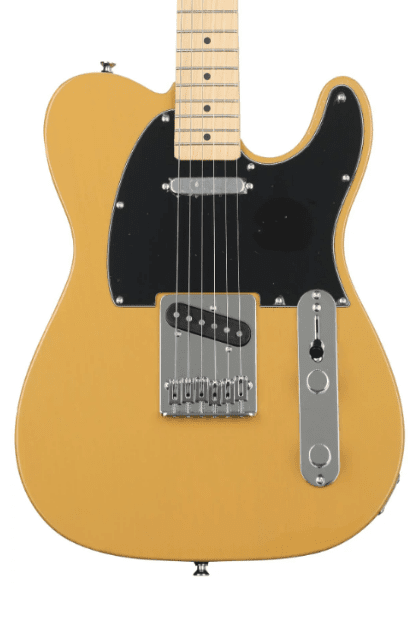
Squier Affinity Series Telecaster
Squier’s mid range Telecaster continues to impress.
Squier’s Affinity line has been a cornerstone of the sub $300 market for years and guitars like perfectly sum up why. It offers fantastic playability, great build quality, and timeless styling. You’ll get all the classic tones the Telecaster is famous for, and you’ll likely be surprised by its versatility.
Our test Squier Affinity Series Telecaster came to us in the classic Butterscotch Blonde, which we really think is the perfect Telecaster color. It wasn’t translucent as you’d find on a Fender version, but we suspect this was likely due to the fact that the bodies of these Squiers are constructed using upwards of 8 pieces of poplar, and an opaque finish tends to disguise mismatched pieces. Being a modern take on the Telecaster, it actually had a belly carve, which helped tremendously with comfort (read our full review here).
As expected, the neck was made from maple, and carved into a very comfortable C profile. This was pretty consistent with other Squier models we’ve tested recently. As for feel, it felt more like an unfinished neck than one with a satin coat. It will likely smooth out with time and use, but felt just a little rough out of the box.
Topping off the maple neck was a maple fretboard. Of course, it looked great against the Butterscotch Blonde finish, and it felt good under the fingers, too. Fretwork was all in order, with no sharps, and decent leveling.
Tonally, the Affinity Telecaster served up all the classic spank you’d expect from these guitars. In the bridge position and played clean, it sounded like a much more expensive guitar than it really was. It did gritty tones just as easily, too. The neck position had some nice warmth and while it was low output, it still delivered good articulation and separation.
Having a string-through body made it was nice and resonant, even sounding good while played unplugged. The hardware was all decent quality, and the sealed gear diecast tuners worked nicely.
Verdict: The Squier Affinity Telecaster is without a doubt the best Tele on the market for under $300. It has great playability, the clean tones were genuinely excellent, and at a glance it’s almost indistinguishable from a Fender-branded model.
- Great looks
- Real Telecaster spank
- Belly carve for comfort
- Partial thickness body
- Neck was a little rough
How to Choose The Right Electric Guitar For You
Shopping for guitars under $300 (as opposed to going for a starter kit with guitar/amp/etc) can be tricky if you’re not sure what to look for. With such a low budget, it can be easy to pick up an unplayable lemon. Below, we’ve detailed some of the most important things for you to look out for when shopping.
Comfortable Setup
A guitar should be comfortable to play, otherwise you’re unlikely to use it. A guitar that is well set up from the factory can make a world of difference. With a good setup, the guitar will have a nice mid-to-low action, a straight neck, and good intonation.
Quality Pickups
Upgrading the pickups on a sub-$300 guitar is often not worth the time, money and effort. A good set of upgraded pickups can cost more than $300, in which case, you’d simply be better off buying a more expensive model in the first place. Consider the tone you’re going for. If you like a hot, brash sound, look for something with ceramic pickups. If you like a rich, smoother sound, alnico pickups are the way to go.
Pickup Type
If you’re buying a guitar with learning a particular genre in mind, it’s important to choose a model that can handle the style you’re looking to play. If you’re looking to play country, or other clean styles, single-coil pickups are the perfect choice. If you’re into metal, single-coil pickups won’t help you get the tones you’re looking for. In that case, you’ll need a guitar with humbuckers to handle the distortion without becoming too noisy.
Fret Finish
Particularly with cheaper guitars, the QA can be hit-or-miss. This is why it’s especially important to be satisfied that the fretwork is well-finished on any guitar you’re considering. This will help ensure that it’s comfortable, and more importantly, that it doesn’t cause injuries.
Final Thoughts
We love taking it back to basics to see what’s possible on a tight budget. We found some really fantastic options in this roundup, all of which offer a lot of performance for not a lot of money.
To recap, we found that our Top Pick, the Yamaha Pacifica PAC112J delivered at a level far exceeding its price point. Our Best Budget pick, the Kramer Focus offered simply incredible value for your money, and was the most affordable by far. Our Editor’s Choice, the Epiphone Les Paul Studio E1 gave us an authentic Les Paul tone and playing experience, while still coming in under budget, and is in our opinion, the best guitar going for under $300.


